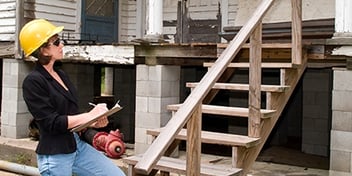The Green PNA: Your road map to asset improvement
 This article was recently published in the Winter 2012/2013 issue of the Affordable Housing News. As it may be of interest to our readers, we're reposting it here.
This article was recently published in the Winter 2012/2013 issue of the Affordable Housing News. As it may be of interest to our readers, we're reposting it here.
In recent years, the U.S. Department of Housing and Urban Development (HUD) has put an increased focus on energy conservation and green asset management. We’ve been hearing a lot of questions about the Green Physical Needs Assessment, or GPNA. What is the GPNA, and how will it affect those of us in the affordable housing industry?
In July of 2011, HUD issued a proposed rule to revise existing regulations governing physical needs assessments (PNAs). The proposed rule would require agencies to project the current modernization and life-cycle replacement repair needs of their projects over a 20-year period. In addition, the rule proposed to integrate the performance of the PNA with the performance of an energy audit.
That’s a big change from the current regulations, which only require five years of planning. However, these proposed changes should be welcomed, not feared. As HUD says in the notice, “The 20-year period coincides better with the useful life of individual properties and their building components and systems to ensure the long-term viability of the property.” The rule also proposes that PNAs be submitted electronically, which will minimize the burden.
With the Green PNA tool now available, and most of
the bugs worked out, it looks like the final rule on
energy audits and PNAs will be coming very soon.
In November of 2011, HUD followed up with a proposed rule on energy audits, which would identify energy-efficient measures that need to be addressed in the audit and lay out the procedures for improved coordination with PNAs. The rule would also define “core energy conservation measures (ECMs)” that must be considered, as well as “advanced ECMs” that agencies could, but would not be required to, consider (such as solar and geothermal power and green construction).
Last year, HUD released a Green PNA tool designed to gather energy audit data and facilitate its integration into long-term capital needs planning (you can find the user guide for the tool here). There are many other resources at HUD’s website that you can download and print out, including:
- A PowerPoint presentation summarizing the new PNA process
- A summary of the public sessions held by HUD
Now is a good time to start familiarizing yourself with the software and making some decisions about how you’ll respond to the new rule.
Specializing in real property services, Jay Ortenzo has been a technical trainer and consultant with Nan McKay and Associates for more than 20 years. With 34 years of housing experience in both public and private sectors, he develops technical training manuals and materials relating to federally subsidized programs on housing inspection, maintenance, and modernization. He recently spoke on HUD’s new GPNA planning tool and software at the Public Housing Authority Directors Association (PHADA) conference in January.
NMA can assist your agency with PNA planning and energy audits. For more information, contact sales@nanmckay.com.


